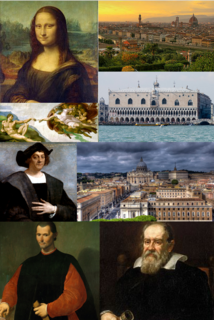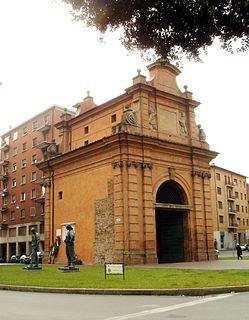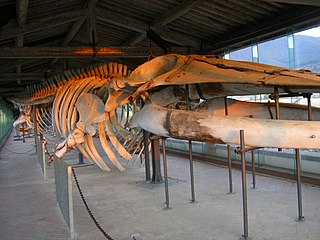 W
WChiesa Parrocchiale di Sant'Agostino is a Roman Catholic parish church on Piazza Sant'Agostino in central Modena, Italy.
 W
WThe University of Camerino is a university located in Camerino, Italy. It is the best university of Italy among those with fewer than 10,000 students, according to the Guida Censis Repubblica 2011 and 2012 ranking. It claims to have been founded in 1336 and was officially recognized by the Pope in 1727. It is organized into five faculties.
 W
WThe Castello Estense or castello di San Michele is a moated medieval castle in the center of Ferrara, northern Italy. It consists of a large block with four corner towers.
 W
WPadula Charterhouse, in Italian Certosa di Padula, is a large Carthusian monastery, or charterhouse, located in the town of Padula, in the Cilento National Park, in Southern Italy. It is a World Heritage site.
 W
WThe Certosa di Pavia is a monastery and complex in Lombardy, northern Italy, situated near a small town of the same name in the Province of Pavia, 8 km north of Pavia. Built in 1396–1495, it was once located on the border of a large hunting park belonging to the Visconti family of Milan, of which today only scattered parts remain. It is one of the largest monasteries in Italy.
 W
WCertosa di San Giacomo was a Carthusian monastery, founded in 1363 by Giacomo Arcucci on the island of Capri, Campania, southern Italy. It is now a museum and is used for cultural events. The buildings that formed the charterhouse have three main areas: the pharmacy and women's church, the buildings for monks, and those for guests. The cloister is of a late Renaissance design, while the Chiostro Piccolo features Roman marble columns.
 W
WThe Certosa di San Martino is a former monastery complex, now a museum, in Naples, southern Italy. Along with Castel Sant'Elmo that stands beside it, this is the most visible landmark of the city, perched atop the Vomero hill that commands the gulf. A Carthusian monastery, it was finished and inaugurated under the rule of Queen Joan I in 1368. It was dedicated to St. Martin of Tours. During the first half of the 16th century it was expanded. Later, in 1623, it was further expanded and became, under the direction of architect Cosimo Fanzago, essentially the structure one sees today.
 W
WCervara Abbey is a former abbey in Santa Margherita Ligure, Liguria region, northern Italy. It is on the coastal road to Portofino. The abbey complex is a designated National Monument of Italy.
 W
WCesenatico is a port town with about 26,000 inhabitants on the Adriatic coast of Italy. It is located in the province of Forlì-Cesena in the region of Emilia-Romagna, about 30 kilometres (19 mi) south of Ravenna. Cesenatico's port canal was surveyed and drawn by Leonardo da Vinci at the request of Cesare Borgia, as part of his plans to fortify the nearby town of Cesena.
 W
WThe Collegio di Spagna is a college for Spanish students at the University of Bologna, Italy, which has been functioning since the 14th century. Its full original name in English translation was the College of Saint Clement of the Spaniards. It has been under the Royal patronage of the Spanish Crown since 1488, as authorized by Pope Innocent VIII.
 W
WThe Cuirassiers Regiment is a Carabinieri Cuirassier regiment acting as honour guard of the President of the Italian Republic. Their motto "Virtus in periculis firmior" means Courage becomes stronger in danger.
 W
WThe University of Ferrara is the main university of the city of Ferrara in the Emilia-Romagna region of northern Italy. In the years prior to the First World War the University of Ferrara, with more than 500 students, was the best attended of the free universities in Italy. Today there are approximately 16,000 students enrolled at the University of Ferrara with nearly 400 degrees granted each year. The teaching staff number 600, including 288 researchers. It is organized into 12 Departments.
 W
WThe Church of San Gaggio is a Roman Catholic church located on via Senese in Florence, Italy. It was once associated with a large convent.
 W
WGaregnano Charterhouse, also known as Milan Charterhouse is a former Carthusian monastery, or charterhouse, located on the outskirts of Milan, Italy, in the Garegnano district. It now houses a community of Capuchin Friars.
 W
WThe Garibaldi Theatre is a theatre in Piazza Armerina, Sicily, southern Italy.
 W
WThe Italian Renaissance, a period in Italian history that covered the 15th (Quattrocento) and 16th (Cinquecento) centuries, developed a culture that spread across Europe and marked the transition from the Middle Ages to modernity. The French word renaissance means "rebirth" and defines the period as one of cultural revival and renewed interest in classical antiquity after the centuries which Renaissance humanists labeled the "Dark Ages". The Renaissance author Giorgio Vasari used the term "Rebirth" in his Lives of the Most Excellent Painters, Sculptors, and Architects in 1550, but the concept became widespread only in the 19th century, after the work of scholars such as Jules Michelet and Jacob Burckhardt.
 W
WPorta delle Lame or Porta Lame was a gate or portal of the former outer medieval walls of the city of Bologna, Italy. It is located at the end of Via Lame, where it meets via Zanardi.
 W
WThe Madonna di Galliera is a church with a Renaissance facade and Baroque interiors, located on Via Manzoni, in central Bologna, Italy. It stands in front of the Palazzo Ghisilardi Fava. The present name over the portal is the Chiesa di Filippini Madonna di Galliera e Filippo Neri.
 W
WMussomeli is a town and comune in the province of Caltanissetta, Sicily, Italy.
 W
WThe Olivetans, formally known as the Order of Our Lady of Mount Olivet, are a monastic order. They were founded in 1313 and recognised 1344. They use the Rule of Saint Benedict and are a member of the Benedictine Confederation, where they are also known as the Olivetan Congregation, but are distinguished from the Benedictines in their habit and organisation. They use the post-nominals 'OSB Oliv'.
 W
WThe Supreme Order of the Most Holy Annunciation is a Roman Catholic order of knighthood, originating in Savoy. It eventually was the pinnacle of the honours system in the Kingdom of Italy, which ceased to be a national order when the kingdom became a republic in 1946. Today, the order continues as a dynastic order under the jurisdiction of the Head of the House of Savoy, Amedeo, 5th Duke of Aosta, who is the order's hereditary Sovereign and Grand Master.
 W
WThe "Osteria Del Cappello" or "Al Cappello Rosso" is an osteria and it is one of the oldest inns in Bologna in Italy, and it is still active today as a hotel and as a restaurant serving food and drinks. It is located in Via de’ Fusari, near Piazza Maggiore.
 W
WPalazzo Corvaja is a medieval palace in Taormina, Sicily, Italy, dating from the 10th century. It was principally built at the end of the 14th century and is named after one of the oldest and most famous families of Taormina, which owned it from 1538 to 1945.
 W
WThe University of Pavia is a university located in Pavia, Lombardy, Italy. There was evidence of teaching as early as 1361, making it one of the oldest universities in the world. It was the sole university in Milan and the greater Lombardy region until the end of the 19th century.
 W
WPisa Charterhouse (Calci Charterhouse} is a former Carthusian monastery, and is the home of the Pisa Museum of Natural History. It is l0 km outside Pisa, Tuscany, Italy.
 W
WThe Certosa di Pontignano, also known as the Certosa di San Pietro, is a Carthusian monastery and church in the neighborhood of Pontignano, within the town limits of Castelnuovo Berardenga, a few kilometers north of the city of Siena, in the region of Tuscany, Italy. The monastic complex, after the expulsion of the monks in 1810, passed through various hands, until it was acquired in 1959 by the University of Siena, and used for academic meetings, conventions, and also hotel and restaurant for events such as weddings and celebrations.
 W
WThe diocese of Cortona was a Roman Catholic ecclesiastical territory in central Italy, which existed from 1325 to 1986. It was immediately subject to the Holy See.
 W
WThe diocese of Montefiascone was a Catholic ecclesiastical territory in Italy. It was created from the diocese of Bagnorea in 1369. In 1986 was united into the diocese of Viterbo, Acquapendente, Bagnoregio, Montefiascone, Tuscania e San Martino al Monte Cimino. The diocese was immediately subject to the Holy See (Papacy).
 W
WSan Francesco is a Gothic-style, Roman Catholic church located in front of the square named after the church, in the historic center of Prato, region of Tuscany, Italy.
 W
WThe Basilica of San Petronio is a minor basilica and church of the Archdiocese of Bologna located in Bologna, Emilia Romagna, northern Italy. It dominates Piazza Maggiore. The basilica is dedicated to the patron saint of the city, Saint Petronius, who was the bishop of Bologna in the fifth century. Construction began in 1390 and its main facade has remained unfinished since. The building was transferred from the city to the diocese in 1929; the basilica was finally consecrated in 1954. It has been the seat of the relics of Bologna's patron saint only since 2000; until then they were preserved in the Santo Stefano church of Bologna.
 W
WThe White Company was a 14th-century English mercenary Company of Adventure, led from its arrival in Italy in 1361 to 1363 by the German Albert Sterz and later by the Englishman John Hawkwood. Although the White Company is the name by which it is popularly known, it was initially called the Great Company of English and Germans and would later often be referred to as the English Company.